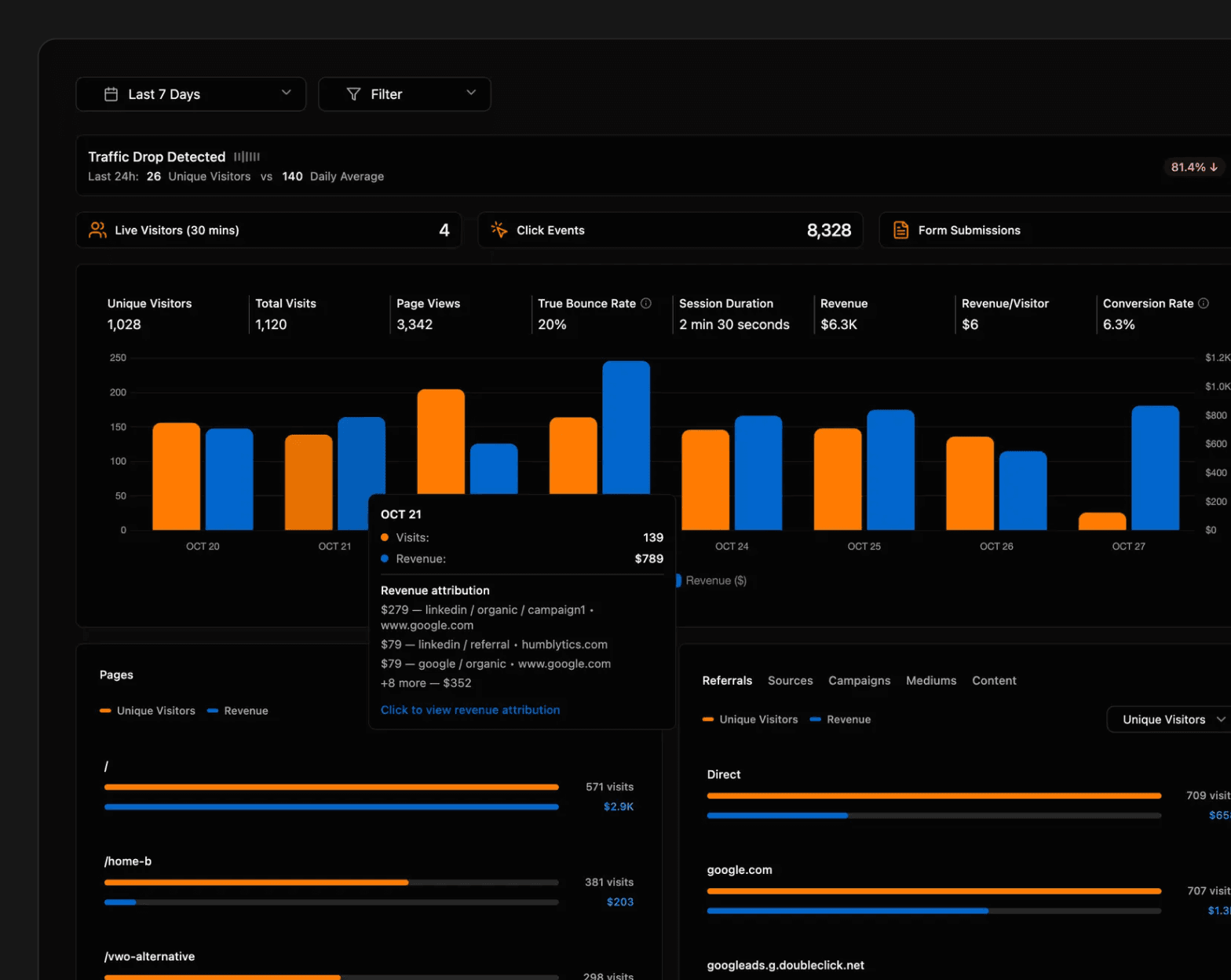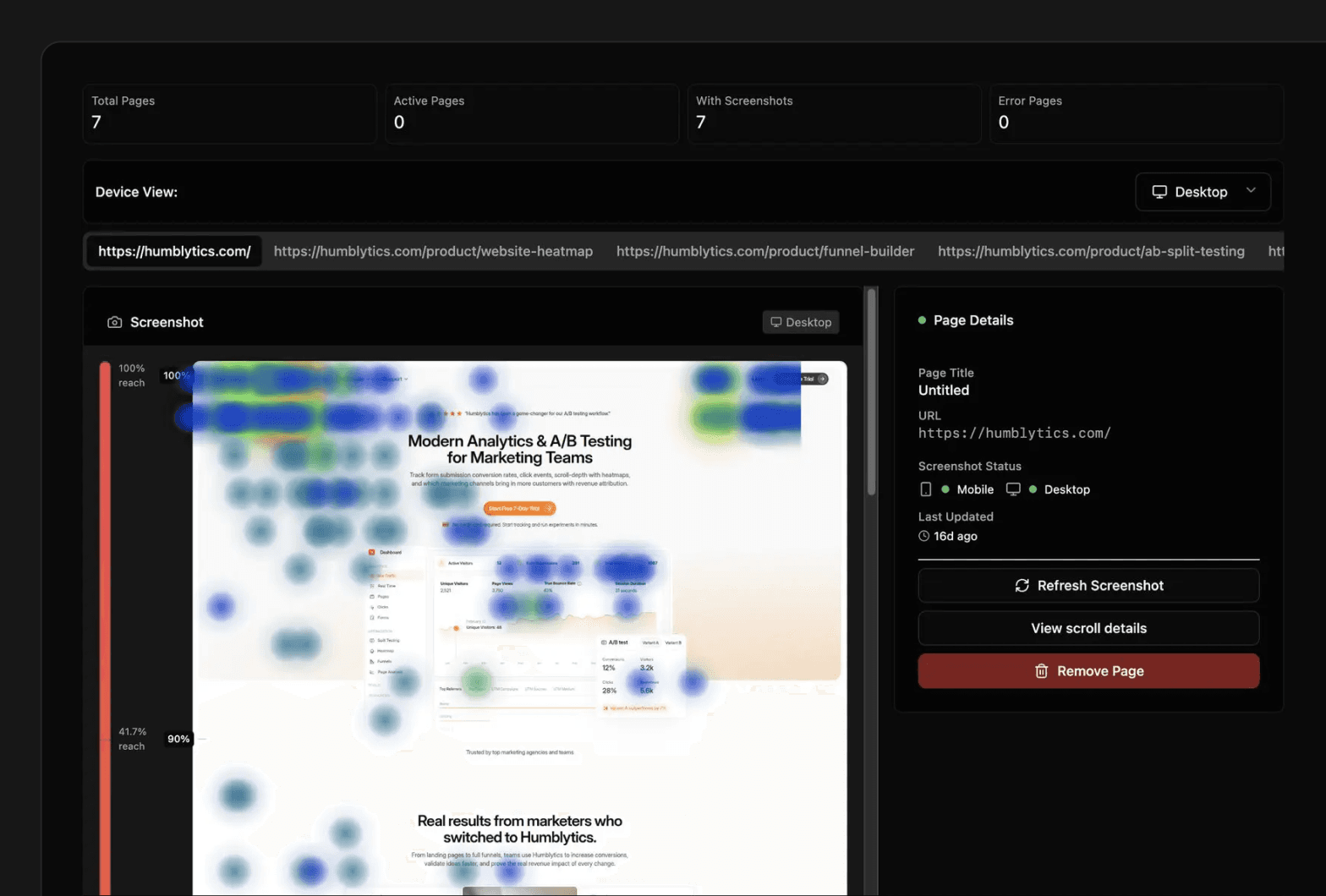
Data Platform
Tinybird Customer Story
Humblytics cuts costs 10x and eliminates database sprints with Tinybird

“With Tinybird, we cut our infrastructure costs by 10x and eliminated these database sprints. We went from spending entire weeks providing zero user value to just focusing on building new features.”
MaxCo-founder, Humblytics
Max and Amir, co-founders of Humblytics, have been building businesses together for over a decade. Their journey with analytics started while running a Webflow agency focused on healthcare clients, where they encountered a recurring problem: managing Google Analytics and custom events across dozens of client sites was exhausting and resource-intensive.
That pain point became the seed for Humblytics - an analytics platform designed to make tracking automatic and insights actionable, without requiring developer dependencies or complex Google Tag Manager setups.
The philosophy: smarter data, more insight
Coming from backgrounds in data analytics and marketing, Max and Amir understood a counterintuitive truth: when you have too much data, sometimes it means nothing at all. Big analytics efforts often fail because teams drown in dashboards without knowing what actually moves the needle.
Humblytics takes a different approach. Instead of requiring marketers to manually configure tracking for every button click and form submission, the platform automatically captures everything with a single script. Then it intelligently parses the data to surface only the insights that matter.
“We come from a background in data analytics and marketing and realize that when you have too much data, sometimes it means nothing at all. A lot of big analytics efforts fail just because there's so much data you look at and you don't know what to actually pull out of it and what is actually going to move the needle for your business.”
AmirCo-founder, Humblytics
The platform integrates directly with tools that marketing teams already use - Cal.com for scheduling, Stripe for payments, Tally for forms, GoHighLevel for CRM. By building integrations around actual use cases rather than forcing users to adapt to their architecture, Humblytics creates a really great analytics experience for marketers.
But delivering on this vision required infrastructure that could handle massive scale while remaining fast and cost-effective.
Timescale worked, until it didn't
When Max and Amir started building Humblytics two years ago, they chose TimescaleDB as their analytics database. It was a logical choice - a Postgres-based time series database that Max was familiar with, performant enough for their early needs, and reasonably priced.
But as Humblytics grew and began processing millions of events per month for creators and brands, the cracks started to appear.
“As we started scaling and as the number of data points we're ingesting per second grew, and as the demands for the amount of data we're querying on the dashboard - especially for the last 30 days, last 6 months - we started running into performance issues very quickly.”
MaxCo-founder, Humblytics
The performance issues weren't subtle. Queries that should have returned in milliseconds were taking 4-5 seconds. For high-traffic customers viewing over a few months of data, dashboards would sometimes fail to load entirely.
Then there was the resource contention problem. Each dashboard tile queried the same underlying data, and with multiple team members viewing dashboards simultaneously, rows would lock and the database would freeze. The row-based architecture that makes Postgres great for transactional workloads was actively working against them for analytics.
“Almost every month we'd have a Timescale sprint where I'd have to spend a week figuring out: do we optimize our SQL queries? Do I go in and fine-tune parameters in Timescale? Or do we just scale vertically up and take the hit on the profit margin?”
MaxCo-founder, Humblytics
The maintenance burden of database sprints
Perhaps worse than the performance issues was the time sink. Every month, Max would dedicate entire sprints to database maintenance - what the team called their "Timescale sprints."
These sprints involved tuning SQL queries, adjusting Timescale parameters, managing compression jobs and hyper table chunk sizes, and inevitably scaling vertically to buy more time. When they enabled continuous aggregations to improve performance, their CPU usage spiked to 100% and the entire database froze.
“The cost was one of the main deciding factors. Timescale was our biggest bill in terms of our entire stack, and it was becoming untenable.”
MaxCo-founder, Humblytics
The cost was also becoming untenable. For a bootstrapped, two-person company serving hundreds of customers, Timescale had become their single largest infrastructure bill at $400-500 per month - and climbing.
By January, it was clear they needed a change. Whatever it took, they had to get off Timescale.

Discovering Tinybird through starter kits
Max had heard of ClickHouse before and knew about its reputation for analytics performance. When Amir mentioned Tinybird - a managed ClickHouse platform - Max was intrigued. Self-hosting ClickHouse was off the table; as a two-person team, they couldn't afford the operational overhead.
What convinced Max to take Tinybird seriously was the web analytics starter kit. With just a few steps, he could see a complete, working analytics implementation built on Tinybird. It just worked.
“I used the Tinybird web analytics starter kit and with one click, I was able to see how you would track web analytics using Tinybird. It all worked very well, and I was pretty excited about it.”
MaxCo-founder, Humblytics
AI-assisted migration in weeks, not months
Max took a methodical approach to the migration. First, he used O3 to plan the entire migration strategy, providing context about their current Timescale stack and desired end state.
Then he built a proof-of-concept using AI to convert their Timescale SQL queries to ClickHouse format. With the schema context from both systems, the LLM made quick work of the translation.
They deployed Tinybird on their own Humblytics marketing site first - "eating their own dog food" to validate performance and data quality. The results were immediately impressive.
Next came the backfill. They wrote data simultaneously to both Timescale and Tinybird during the migration period, gradually moving customer workloads over as they validated the new system.
“I used O3 to just plan out the migration - here's our current stack, here's the current code, what would it take to migrate? Then I did a proof of concept prototype using Sonnet 4. In the span of a couple of weeks, here's what our codebase would look like if we were using Tinybird.”
MaxCo-founder, Humblytics
One challenge they faced with Timescale was tracking session duration and bounce rates. Their Timescale implementation used UPDATE queries - when a user left a page, they'd update the original row with session length and bounce data.
ClickHouse doesn't work that way. Instead, Max implemented a pattern where they insert a new row for each event, then use a Tinybird pipe to select the latest row for each session. This approach actually proved more efficient than their previous UPDATE pattern.
10x better on every dimension
The results after migration were dramatic. Queries that took 4-5 seconds on Timescale now complete in 300 milliseconds or less on Tinybird - even when querying 90+ days of data for high-traffic sites.
Dashboards that previously timed out now load almost instantly. The resource contention issues vanished entirely. Multiple team members can query the same data simultaneously without any performance degradation.
“For querying the last 90 days of data for a high-traffic site, on Timescale we were seeing it would take 4 or 5 seconds to load that data. On Tinybird, we're at 300 milliseconds or less.”
MaxCo-founder, Humblytics
The cost difference was equally striking. Humblytics went from paying $400-500 per month for Timescale to less than $50 per month for Tinybird - a 10x reduction - while processing up to 150 million events monthly and serving hundreds of customers.
But perhaps the most valuable change was what didn't happen. Those monthly Timescale sprints? Gone. Max no longer spends entire weeks tuning compression jobs, adjusting chunk sizes, or scaling vertically just to maintain acceptable performance.
Instead, Max can now dedicate those engineering sprints to building new features and improvements that customers actually want. Without the constant burden of database maintenance, the team is able to focus on their product roadmap and respond more quickly to customer feedback.

“Those Timescale database sprints - we were providing zero value to our users during that sprint. Now we're focused on everything else except the database. It's running in the background, and I don't have to worry about compression jobs, hyper table chunk sizes, any of that.”
MaxCo-founder, Humblytics
Observability that actually helps
One unexpected benefit was Tinybird's built-in observability. With Timescale, debugging data quality issues meant combing through logs to find errors. With Tinybird, Max can see quarantined rows that weren't inserted - complete with the reason why.
He can review the quarantined data, fix any schema issues, and either discard the bad rows or repair and reinsert them. It transforms data quality management from a guessing game into a straightforward process.
“With Timescale, we used to have challenges where it seems like we're missing some data or it's not being properly recorded, and we'd have to comb through logs to find the error. With Tinybird, I just log into the workspace and here's your quarantined rows that weren't inserted for this reason. Very great observability and very easy to manage.”
MaxCo-founder, Humblytics
Building for an agentic future
Max and Amir are currently migrating Humblytics' frontend from Svelte to React, and they're building with AI-native features in mind from the start.
They envision a Cursor-style chat interface where users can interact with their data conversationally. AI agents will analyze sites in the background, generate optimization recommendations, and automatically run split tests using Humblytics' no-code editor.
This vision requires infrastructure that can handle complex queries across large datasets without slowing down. It requires a platform that won't become a bottleneck as they scale. And it requires a database they can trust to work, in real-time, without constant maintenance.
“It's not just about the conversations we're having - it's about the conversations we're NOT having anymore. The fact that we don't have to talk about performance and cost, that's such a big deal for us. We're future-proofing this as we build out more AI and agentic features.”
AmirCo-founder, Humblytics
For a bootstrapped two-person team processing millions of events and serving hundreds of customers, Tinybird has removed analytics infrastructure as a concern entirely. The database runs in the background, handling massive scale efficiently and cost-effectively while Max and Amir focus on building features that matter.
As Amir put it, the most important change isn't what they can do now - it's the conversations they no longer need to have about database performance and cost.
Discover the power
of real‑time analytics

